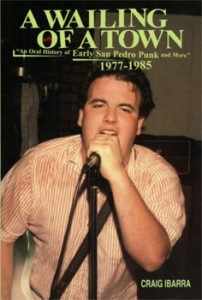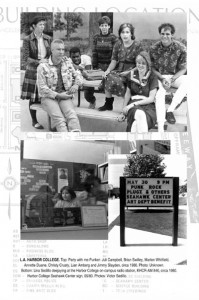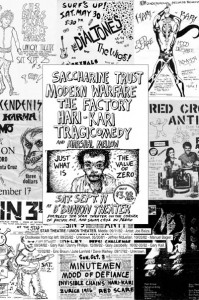A WAILING OF A TOWN: EARLY SAN PEDRO PUNK 77-85
[Punk USA] Extraits du Livre de Craig Ibarra (EndFwy 2015)
A WAILING OF A TOWN: AN ORAL HISTORY OF EARLY SAN PEDRO PUNK AND MORE 1977-1985
 EXTRAIT (Joe Nolte): « We would not see much of the Church for some time after the first rainy afternoon, mostly since Black Flag were still keeping their old practice space on Aviation Boulevard, and my own band was busy that Spring recording our first album (L.A Explosion). While we are otherwise engaged, The Descendents will play their second and last gig with my brother David (singing) at a party in Long Beach, which turns into a biker brawl; and a St Patrick’s Day show with the Alley Cats, Go-Go’s and X will turn into Los Angeles’ first full-scale punk rock riot. The gas shortage will hit epidemic proportions, peaking on May 6, 1979, when not a single gas station in the South Bay is able to open. Then, on June 17, Redondo’s Fleetwood opens its doors to the aforementioned Go-Go’s and Alley Cats. Unfortunately for the club, the bill also includes those fun-loving ministers of mayhem, the Germs, as well as the Plugz and the Bags. Even more unfortunately, a new scene has erupted down south, behind the Orange Curtain. Abunch of teenagers in Huntington Beach have discovered punk rock. They are quickly met with the same hostility we have encountered, but down there it’s a little different. There are more of them. They have sufficient numbers to fight back, thus rather quickly developing a survivalist sort of gang mentality, which manifests itself on this particular Sunday. For the South Bay locals, it is simultaneously the scariest and most refreshing thing they haver ever seen. »
EXTRAIT (Joe Nolte): « We would not see much of the Church for some time after the first rainy afternoon, mostly since Black Flag were still keeping their old practice space on Aviation Boulevard, and my own band was busy that Spring recording our first album (L.A Explosion). While we are otherwise engaged, The Descendents will play their second and last gig with my brother David (singing) at a party in Long Beach, which turns into a biker brawl; and a St Patrick’s Day show with the Alley Cats, Go-Go’s and X will turn into Los Angeles’ first full-scale punk rock riot. The gas shortage will hit epidemic proportions, peaking on May 6, 1979, when not a single gas station in the South Bay is able to open. Then, on June 17, Redondo’s Fleetwood opens its doors to the aforementioned Go-Go’s and Alley Cats. Unfortunately for the club, the bill also includes those fun-loving ministers of mayhem, the Germs, as well as the Plugz and the Bags. Even more unfortunately, a new scene has erupted down south, behind the Orange Curtain. Abunch of teenagers in Huntington Beach have discovered punk rock. They are quickly met with the same hostility we have encountered, but down there it’s a little different. There are more of them. They have sufficient numbers to fight back, thus rather quickly developing a survivalist sort of gang mentality, which manifests itself on this particular Sunday. For the South Bay locals, it is simultaneously the scariest and most refreshing thing they haver ever seen. »
EXTRAIT (Gigi): « I was becoming a hardcore punk rocker. The shows themselves were great, and I saw the last Germs show, but the hardcore boys and girls were basically jerks, and they made the scene suck. Talk about the lowest common denominator. I was reading an interview with Mike Brinson, and he talked about how many of the people in the Pedro scene were really smart. Most of us were self-educated, working class people who had a unique take on life, because by the time we were 12, we had seen quite a lot in our neighborhoods. The O.C kids seemed nihilistic, with an almost Nazi-youth-follower sensibility. They were scary and they were racist. One night, I was driving some of them home, and they were joking about how they were gonna rape me. I turned on them and destroyed every one of them with a lecture about how they should go back to their confortable homes and families and get the fuck out of the punk scene. I hated ’em. They would beat up anyone who didn’t conform to their fashion sense – or should I say, their fascist sense. There were things about the punk scene that I loved, but beating up on gays was not one of them. »
EXTRAI T (Mike Watt): We started with 300$ each. We tried to make it pay for itself, ’cause we lived econo. We didn’t spend a lot on it, and also, there were some pretty good success like the Hüsker Dü and Descendents albums. Singles were really cheap to put out in those days. A lot of the New Alliance releases aren’t albums. There’s a lot of 7-inches. They were so much more econo. (Danny Phillips): Il imagine New Alliance was a spin-off of SST. Mike told me there were certain records that they wanted to do, but SST didn’t want to do ’em, so they started their own label and did ’em. (Mike Watt): I was working at SST at this time. I was building the antenna tuners. They also had me calling college radio stations as Spaceman to try and get radio play. New Alliance is like a little version of SST. You do the most with what little you have. (Chuck Dukowski): The Minutemen’s label – doing records from themselves and friends. They had an idealistic populist vision and put out interesting music. »
T (Mike Watt): We started with 300$ each. We tried to make it pay for itself, ’cause we lived econo. We didn’t spend a lot on it, and also, there were some pretty good success like the Hüsker Dü and Descendents albums. Singles were really cheap to put out in those days. A lot of the New Alliance releases aren’t albums. There’s a lot of 7-inches. They were so much more econo. (Danny Phillips): Il imagine New Alliance was a spin-off of SST. Mike told me there were certain records that they wanted to do, but SST didn’t want to do ’em, so they started their own label and did ’em. (Mike Watt): I was working at SST at this time. I was building the antenna tuners. They also had me calling college radio stations as Spaceman to try and get radio play. New Alliance is like a little version of SST. You do the most with what little you have. (Chuck Dukowski): The Minutemen’s label – doing records from themselves and friends. They had an idealistic populist vision and put out interesting music. »
EXTRAIT (Lina Sedillo): « Harbor was really interesting during that time – late 70s, early 80s – most all the punks and bands that were in the area were going there and would congregate between classes, so you could always find out what was going on, gig and party-wise. Because the Harbor Area was still isolated from the Hollywood scene, having other people like yourself to hang around was a huge deal. Plus, the punks there were smart. They were really into educating themselves, which I think was another significant difference from a lot of the L.A crowd. »
 EXTRAIT (Ian MacKaye): I think I booked the Minor Threat show at Dancing Waters with John Macias from Circle One. (…) I’m pretty sure Richard Bultom put the show on. It was M.I.A, Dr Know, Minor Threat and Circle One. Black Flag were all there and they came up and did maybe four songs. They sort of just jumped on stage. Of course, Dancing Waters had the waterfall that was behind the stage; which was pretty surreal. During that gig, I remember at one point, I was in the front of the stage just really leaning into the crowd and singing. There was this one particularly animated person in the front just going off! As I was singing, he suddenly leaned over and bit my arm and I cracked him. I gave him a little shot. That was not uncommon at that time. There was always that sort of shit going on. People would punch you or pull your feet out from underneath you or whatever. I had people come on stage and attack me. It was almost like being tested – he bit me and I punched him. I wasn’t that freaked out about it and he didn’t seem all that freaked out either. Afterwards, this guy comes up to me and he says, « I can’t believe you punched that guy. I can’t believe you just punched him » I go, « You mean that guy that bit me? » He goes, « Yeah, it was Jay Adams. » I was like, « Holy fuck! That was Jay Adams? » I was a huge Jay Adams fan from the ’70s as a skateboarder, and Jay was sort of my hero. »
EXTRAIT (Ian MacKaye): I think I booked the Minor Threat show at Dancing Waters with John Macias from Circle One. (…) I’m pretty sure Richard Bultom put the show on. It was M.I.A, Dr Know, Minor Threat and Circle One. Black Flag were all there and they came up and did maybe four songs. They sort of just jumped on stage. Of course, Dancing Waters had the waterfall that was behind the stage; which was pretty surreal. During that gig, I remember at one point, I was in the front of the stage just really leaning into the crowd and singing. There was this one particularly animated person in the front just going off! As I was singing, he suddenly leaned over and bit my arm and I cracked him. I gave him a little shot. That was not uncommon at that time. There was always that sort of shit going on. People would punch you or pull your feet out from underneath you or whatever. I had people come on stage and attack me. It was almost like being tested – he bit me and I punched him. I wasn’t that freaked out about it and he didn’t seem all that freaked out either. Afterwards, this guy comes up to me and he says, « I can’t believe you punched that guy. I can’t believe you just punched him » I go, « You mean that guy that bit me? » He goes, « Yeah, it was Jay Adams. » I was like, « Holy fuck! That was Jay Adams? » I was a huge Jay Adams fan from the ’70s as a skateboarder, and Jay was sort of my hero. »